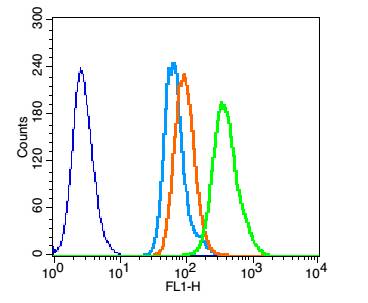
Rabbit Anti-phospho-Brk (Tyr447)antibody
Brk (phospho Y447); p-Brk (phospho Y447); Breast tumor kinase; Breast tumour kinase; Protein tyrosine kinase 6; PTK6; Tyrosine protein kinase BRK; PTK6_HUMAN.
View History [Clear]
Details
Product Name phospho-Brk (Tyr447) Chinese Name 磷酸化酪氨酸蛋白激酶6/乳腺Tumour激酶抗体 Alias Brk (phospho Y447); p-Brk (phospho Y447); Breast tumor kinase; Breast tumour kinase; Protein tyrosine kinase 6; PTK6; Tyrosine protein kinase BRK; PTK6_HUMAN. literatures Product Type Phosphorylated anti Research Area Tumour Cell biology Signal transduction Kinases and Phosphatases Immunogen Species Rabbit Clonality Polyclonal React Species Human, Applications WB=1:500-2000 ELISA=1:5000-10000 IHC-P=1:100-500 IHC-F=1:100-500 Flow-Cyt=3μg/Test ICC=1:100-500 IF=1:100-500 (Paraffin sections need antigen repair)
not yet tested in other applications.
optimal dilutions/concentrations should be determined by the end user.Theoretical molecular weight 52kDa Cellular localization The nucleus cytoplasmic The cell membrane Form Liquid Concentration 1mg/ml immunogen KLH conjugated synthesised phosphopeptide derived from human Brk around the phosphorylation site of Tyr447: TS(p-Y)EN Lsotype IgG Purification affinity purified by Protein A Buffer Solution 0.01M TBS(pH7.4) with 1% BSA, 0.03% Proclin300 and 50% Glycerol. Storage Shipped at 4℃. Store at -20 °C for one year. Avoid repeated freeze/thaw cycles. Attention This product as supplied is intended for research use only, not for use in human, therapeutic or diagnostic applications. PubMed PubMed Product Detail This protein encoded is a cytoplasmic nonreceptor protein kinase which may function as an intracellular signal transducer in epithelial tissues. Overexpression of this gene in mammary epithelial cells leads to sensitization of the cells to epidermal growth factor and results in a partially transformed phenotype. Expression of this gene has been detected at low levels in some breast tumors but not in normal breast tissue. Its presence in the nucleus appears to be linked to suppression of tumor progression. The encoded protein has been shown to undergo autophosphorylation.
Function:
Non-receptor tyrosine-protein kinase implicated in the regulation of a variety of signaling pathways that control the differentiation and maintenance of normal epithelia, as well as tumor growth. Function seems to be context dependent and differ depending on cell type, as well as its intracellular localization. A number of potential nuclear and cytoplasmic substrates have been identified. These include the RNA-binding proteins: KHDRBS1/SAM68, KHDRBS2/SLM1, KHDRBS3/SLM2 and SFPQ/PSF; transcription factors: STAT3 and STAT5A/B and a variety of signaling molecules: ARHGAP35/p190RhoGAP, PXN/paxillin, BTK/ATK, STAP2/BKS. Associates also with a variety of proteins that are likely upstream of PTK6 in various signaling pathways, or for which PTK6 may play an adapter-like role. These proteins include ADAM15, EGFR, ERBB2, ERBB3 and IRS4. In normal or non-tumorigenic tissues, PTK6 promotes cellular differentiation and apoptosis. In tumors PTK6 contributes to cancer progression by sensitizing cells to mitogenic signals and enhancing proliferation, anchorage-independent survival and migration/invasion. Association with EGFR, ERBB2, ERBB3 may contribute to mammary tumor development and growth through enhancement of EGF-induced signaling via BTK/AKT and PI3 kinase. Contributes to migration and proliferation by contributing to EGF-mediated phosphorylation of ARHGAP35/p190RhoGAP, which promotes association with RASA1/p120RasGAP, inactivating RhoA while activating RAS. EGF stimulation resulted in phosphorylation of PNX/Paxillin by PTK6 and activation of RAC1 via CRK/CrKII, thereby promoting migration and invasion. PTK6 activates STAT3 and STAT5B to promote proliferation. Nuclear PTK6 may be important for regulating growth in normal epithelia, while cytoplasmic PTK6 might activate oncogenic signaling pathways.
Subunit:
Interacts with GAP-A.p65. Interacts (via SH3 and SH2 domains) with KHDRBS1. Interacts (via SH3 and SH2 domains) with phosphorylated IRS4. Interacts with ADAM15. Interacts (via SH3 domain) with SFPQ. Interacts with EGFR and ERBB2. Interacts with STAP2. Interacts with PNX. Interacts with SFPQ. Interacts with PTK/ATK. Interacts with CTNNB1.
Subcellular Location:
Epithelia-specific. Very high level in colon and high levels in small intestine and prostate, and low levels in some fetal tissues. Not expressed in breast or ovarian tissue but expressed in high pourcentage of breast and ovarian cancers. Also overexpressed in some metastatic melanomas, lymphomas, colon cancers, squamous cell carcinomas and prostate cancers. Also found in melanocytes. Not expressed in heart, brain, placenta, lung, liver, skeletal muscle, kidney and pancreas. Isoform 2 is present in prostate epithelial cell lines derived from normal prostate and prostate adenocarcinomas, as well as in a variety of cell lines.
Tissue Specificity:
Epithelia-specific. Very high level in colon and high levels in small intestine and prostate, and low levels in some fetal tissues. Not expressed in breast or ovarian tissue but expressed in high pourcentage of breast and ovarian cancers. Also overexpressed in some metastatic melanomas, lymphomas, colon cancers, squamous cell carcinomas and prostate cancers. Also found in melanocytes. Not expressed in heart, brain, placenta, lung, liver, skeletal muscle, kidney and pancreas. Isoform 2 is present in prostate epithelial cell lines derived from normal prostate and prostate adenocarcinomas, as well as in a variety of cell lines.
Post-translational modifications:
Autophosphorylated. Autophosphorylation of Tyr-342 leads to an increase of kinase activity. Tyr-447 binds to the SH2 domain when phosphorylated and negatively regulates kinase activity.
Similarity:
Belongs to the protein kinase superfamily. Tyr protein kinase family. BRK/PTK6/SIK subfamily.
Contains 1 protein kinase domain.
Contains 1 SH2 domain.
Contains 1 SH3 domain.
SWISS:
Q13882
Gene ID:
5753
Database links:Entrez Gene: 5753 Human
Entrez Gene: 20459 Mouse
Omim: 602004 Human
SwissProt: Q13882 Human
SwissProt: Q64434 Mouse
Product Picture
Bought notes(bought amounts latest0)
No one bought this product
User Comment(Total0User Comment Num)
- No comment



 +86 571 56623320
+86 571 56623320
 +86 18668110335
+86 18668110335

